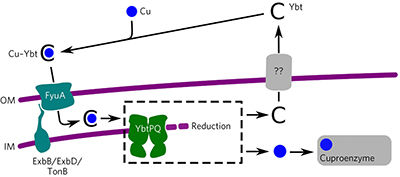当前位置:
X-MOL 学术
›
Nat. Chem. Biol.
›
论文详情
Our official English website, www.x-mol.net, welcomes your
feedback! (Note: you will need to create a separate account there.)
Copper import in Escherichia coli by the yersiniabactin metallophore system
Nature Chemical Biology ( IF 12.9 ) Pub Date : 2017-07-24 00:00:00 , DOI: 10.1038/nchembio.2441 Eun-Ik Koh , Anne E Robinson , Nilantha Bandara , Buck E Rogers , Jeffrey P Henderson
Nature Chemical Biology ( IF 12.9 ) Pub Date : 2017-07-24 00:00:00 , DOI: 10.1038/nchembio.2441 Eun-Ik Koh , Anne E Robinson , Nilantha Bandara , Buck E Rogers , Jeffrey P Henderson

|
Copper plays a dual role as a nutrient and a toxin during bacterial infections. While uropathogenic Escherichia coli (UPEC) strains can use the copper-binding metallophore yersiniabactin (Ybt) to resist copper toxicity, Ybt also converts bioavailable copper to Cu(II)–Ybt in low-copper conditions. Although E. coli have long been considered to lack a copper import pathway, we observed Ybt-mediated copper import in UPEC using canonical Fe(III)–Ybt transport proteins. UPEC removed copper from Cu(II)–Ybt with subsequent re-export of metal-free Ybt to the extracellular space. Copper released through this process became available to an E. coli cuproenzyme (the amine oxidase TynA), linking this import pathway to a nutrient acquisition function. Ybt-expressing E. coli thus engage in nutritional passivation, a strategy of minimizing a metal ion's toxicity while preserving its nutritional availability. Copper acquisition through this process may contribute to the marked virulence defect of Ybt-transport-deficient UPEC.
中文翻译:

耶尔西菌素金属荧光体系统在大肠杆菌中的铜进口
铜在细菌感染期间既充当营养物又充当毒素。泌尿致病性大肠杆菌(UPEC)菌株可以利用结合铜的金属耶尔酵母菌素(Ybt)抵抗铜的毒性,而Ybt还在低铜条件下将可生物利用的铜转化为Cu(II)–Ybt。尽管长期以来人们一直认为大肠杆菌缺乏铜的导入途径,但我们观察到UPEC中使用典型的Fe(III)–Ybt转运蛋白通过Ybt介导的铜导入。UPEC从Cu(II)–Ybt中去除了铜,随后将无金属的Ybt再出口到细胞外空间。通过此过程释放的铜可用于大肠杆菌铜酶(胺氧化酶TynA),将这种导入途径与营养获取功能联系起来。因此,表达Ybt的大肠杆菌参与了营养钝化,这是一种在保持金属营养可利用性的同时将金属离子的毒性降至最低的策略。通过此过程获得的铜可能会导致Ybt-运输缺陷的UPEC的明显毒力缺陷。
更新日期:2017-08-19
中文翻译:

耶尔西菌素金属荧光体系统在大肠杆菌中的铜进口
铜在细菌感染期间既充当营养物又充当毒素。泌尿致病性大肠杆菌(UPEC)菌株可以利用结合铜的金属耶尔酵母菌素(Ybt)抵抗铜的毒性,而Ybt还在低铜条件下将可生物利用的铜转化为Cu(II)–Ybt。尽管长期以来人们一直认为大肠杆菌缺乏铜的导入途径,但我们观察到UPEC中使用典型的Fe(III)–Ybt转运蛋白通过Ybt介导的铜导入。UPEC从Cu(II)–Ybt中去除了铜,随后将无金属的Ybt再出口到细胞外空间。通过此过程释放的铜可用于大肠杆菌铜酶(胺氧化酶TynA),将这种导入途径与营养获取功能联系起来。因此,表达Ybt的大肠杆菌参与了营养钝化,这是一种在保持金属营养可利用性的同时将金属离子的毒性降至最低的策略。通过此过程获得的铜可能会导致Ybt-运输缺陷的UPEC的明显毒力缺陷。











































 京公网安备 11010802027423号
京公网安备 11010802027423号